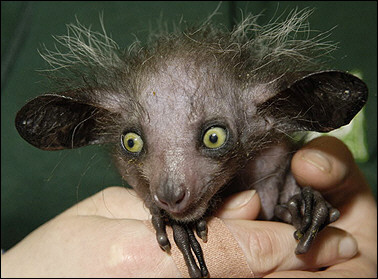|
|
|
|
|
|
|
 |
|

|
| otarafa: burhan doğançay'ın özgün litograf baskıları | butarafa: ok |
|
aye aye
|
|
Scientific name: Daubentonia madagascariensis Country: Madagascar Continent: Africa Diet: Nuts - nucivore, nectar from Traveler's palm - nectarivore, insect grubs - lavivore Food & feeding: Omnivore Habitats: Tropical rainforest, tropical dry forest Conservation status: Endangered Relatives: Ring-tailed lemur, Mongoose lemur, Indri Description: The Aye-aye is a medium-sized nocturnal lemur, weighing approximately 3 kg. That is about where the similarity to any other lemur ends. The rest of the animal is an extraordinary compilation of features that look like they have come from other animals. The head is equipped with large dish-like ears that can be rotated independently, capable of picking up the slightest sound at night. The front incisor teeth grow continuously, rather like a squirrel, so that they never wear down. The eyes are large and orange and the nose is pink. The fingers on the hands are all very long - and the middle finger especially so - it looks almost like a skeleton finger with skin stretched over the top. Quite an animal! Lifestyle: The forests of Madagascar have no woodpeckers. The Aye-aye is a lemur that has evolved to feed almost like a woodpecker. At night, it clambers around dead trees and taps the bark all over with its skinny middle finger. If the bark sounds hollow the Aye-aye stops and uses its supersensitive hearing to listen for the movements of insect grubs beneath the bark. When it hears something, it rips the bark up using its long, powerful front teeth and then uses that skinny middle finger to fish the grub out of its hole - rather like eating cheese on a cocktail stick. It also uses its sharp teeth to gnaw into coconuts and other seeds, again using the middle finger to scoop the soft insides out. Family & friends: Aye-ayes are solitary creatures. Males cover up to four kilometres a night, in large overlapping territories. Chance meetings are often aggressive. When the females are ready to mate, males often fight each other for the privilege. Keeping in touch: On their travels, Aye-ayes leave messages for others in the form of urine scent marks and by rubbing special glands in their neck, cheeks and bottom onto branches. Females call in the dead of night to attract males when they are ready to mate - their calls are often answered by more than one male. Growing up: After a pregnancy that last about 160 days, a single baby is born. The young Aye-aye feeds on its mother's milk for a year - and this long weaning period means that the mother can only care for a baby every two or three years. In captivity, Aye-ayes have been known to live for up to 23 years. Conservation news: The aye-aye is the centre of many local superstitious beliefs - some of which protect the Aye-aye, but others result in persecution. Due to deforestation and persecution, the population dramatically declined in size and, by the 1980s, only a few scattered individuals were thought to remain. Recent research has shown that Aye- ayes are more widely distributed than previously thought and sightings have thankfully increased. A protected Aye-aye reserve off the northeast coast of Madagascar - Nosy Mangabe - has now been established. |

|
|
| tiscasting |
|
|
| at least he is cutE! UNLIKE YOU! |
|
|
| yemek istiicem kadar muhTesem bumeret - |
|
|
|
evrim geçirmiş rulo şeklindeki baş parmağini* açıp kendi boyu kadar hale getirip, onu güçlü dişleriyle üstüde delik açtığı ağaca sokan, bu parmakla kurtcukları avlayıp yiyen, kurgusal hayvanmış bu bidi. orta parmağı vücüduna oranla en uzun hayvanmış - konudan bağımsız olarak katilar icinde yarasa duyusu ve sonar kullanabilen tek kemirgenmiş şekspir inde orta parmağının ismidir ayrıca - |
|
|
| vay be. |
|
|
|
What do Aye-Aye Sound Like? They are quiet animals and don't say much. But, they do make noise as they tap and sniff at branches looking for food. Malagasy law prohibits the killing or unauthorised capture of any lemurs. However, this law is often impossible to enforce. |
|
|
|
teknik spec olarak : |
|
boşlukları doldurun
bunlara da göz atabilirsiniz:
|
| otarafa: burhan doğançay'ın özgün litograf baskıları | butarafa: ok |
| iletişim - şikayet - kullanıcı sözleşmesi - gizlilik şartları |

